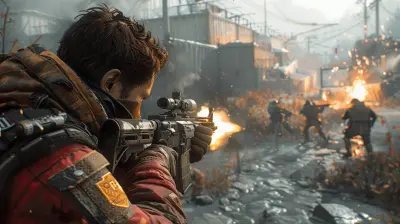Breaking Down Frame Data: The Secret to Winning Fights
16 August 2025
When it comes to competitive fighting games, victory isn't just about button-mashing or flashy combos—it's about knowledge, precision, and timing. If you've ever watched professionals play and wondered how they predict their opponent's every move or why they punish mistakes with pinpoint accuracy, the answer lies in one key concept: frame data.
Frame data can sound intimidating at first, like some complicated math formula that only the pros can understand. But trust me—it’s a lot simpler than it seems, and once you grasp it, you'll unlock a whole new level of gameplay. Think of it as the blueprint for understanding how a fighting game operates. By the time we’re done here, you’ll begin to see frame data as less of a mystery and more as your personal cheat code to domination.
Let’s break it all down step by step, shall we?
What Is Frame Data?
Before we dive into the nitty-gritty, let’s start with the basics: What even is frame data? Put simply, frame data is the information that tells you how fast or slow moves occur in a fighting game. Every move is made up of frames—individual moments in time measured in 1/60th of a second.Imagine watching a flipbook animation. Each frame is like one page in the book. Now, fighting games animate characters in frames, and every punch, kick, or block is just a sequence of these animations playing out.
Frame data breaks all of this down into numbers. Those numbers tell you three key things about a move:
1. Startup Frames: How long does it take before the move actually hits your opponent?
2. Active Frames: How long does the move stay "active"—i.e., how big is your window to connect with a hit?
3. Recovery Frames: How long does your character take to finish the move and return to a neutral stance?
By understanding these timings, you’ll know whether a move is safe to use, good for countering, or just plain risky.
Why Is Frame Data Important?
Frame data is the fighting game equivalent of reading your opponent's playbook. Knowing it allows you to:- Punish mistakes effectively: If your opponent whiffs a move (swings and misses), frame data tells you how fast you can respond.
- Optimize your combos: You’ll know which moves string together seamlessly and which ones leave gaps for your opponent to slip out.
- Defend smarter: Is that attack safe on block? Should you counter or back off? Frame data has your back.
Let’s put it this way: Without frame data, you’re fighting blind. With frame data, you’re playing chess while everyone else is playing checkers.
The Anatomy of a Move in Frame Data
Now that we've covered what frame data is, let’s break it down further. Each move in a fighting game typically has three main phases, represented by the frames we mentioned earlier. Here's how it all fits together:Startup
The startup frames are the "wind-up" phase of a move. It’s the time between pressing a button and your character actually landing the hit. Think of it like pulling back a slingshot before letting it go.Moves with fewer startup frames are faster and harder for your opponent to react to. On the flip side, slower startup moves are easier to see coming but often pack a bigger punch.
Active
Active frames are when the move is "live" and able to connect with your opponent. In this phase, the attack hits if your opponent is in its range.Picture shoving your hand forward to pop a balloon—there’s only a small window where your hand is in the right spot to make it burst.
Recovery
Recovery frames happen after your move is done. During this time, your character is "stuck" finishing the animation. You can't attack, block, or move until recovery is complete.This is where the real strategy comes into play. Moves with long recovery frames leave you wide open for punishment. On the other hand, quick-recovery moves let you get back into the action instantly.
By understanding these three phases, you can make smarter decisions about when—and how—to attack.
Key Terms You Should Know
Before we move on, let’s quickly define some essential frame data lingo that you’ll encounter:- Frame Advantage: The difference in recovery time between you and your opponent after a move. If you have frame advantage, you can act before they can.
- Safe on Block: A move that leaves you with enough frame advantage after being blocked to avoid being punished.
- Whiff Punish: Taking advantage of an opponent missing an attack by quickly retaliating.
- Invincibility Frames: Frames where your character cannot be hit, often during special moves or dodges.
How to Use Frame Data to Win Matches
Now that you know the basics, let’s talk about practical applications. How do you actually use frame data in a match to gain an edge?1. Punishing Unsafe Moves
Have you ever felt like your opponent keeps getting away with sloppy attacks? That’s probably because you didn’t know how to punish them properly. By studying frame data, you’ll learn which moves leave opponents vulnerable and what you can do to capitalize on their mistakes.For example, after blocking a heavy kick with long recovery frames, use a fast move with low startup frames to punish them.
2. Choosing the Right Moves
Not all moves are created equal. Some are great for starting combos, while others are better for ending them. Frame data helps you figure out the best tools for the job.For instance, fast moves (with low startup) are ideal for interrupting opponents, while moves with high frame advantage on block can help you maintain pressure.
3. Blocking Smarter
Blocking too much in a fighting game can get you into trouble, but attacking recklessly isn’t the answer either. Frame data lets you know which moves are safe to block and which ones you shouldn’t mess around with.If your opponent uses a move that’s unsafe on block, you can retaliate immediately. But if it’s safe, it’s better to back off or reposition.
4. Improving Your Combos
Ever tried landing a combo only for your opponent to slip out halfway through? That’s because the moves you chose didn’t connect properly. Frame data lets you craft combos that leave no gaps, ensuring maximum damage.Tips for Learning Frame Data
Now, you might be thinking, “This all sounds great, but where do I even start?” Don’t worry—I’ve got you covered.Start Small
Don’t overwhelm yourself by trying to memorize every single frame for every move. Begin with a handful of characters or moves that you use the most.Use Training Mode
Most modern fighting games have detailed training modes that let you simulate different scenarios. Use these tools to experiment and see frame data in action.Watch Professionals
Watching high-level players is one of the best ways to learn. Pay attention to how they punish mistakes, manage spacing, and use frame-perfect combos.Frame Data Isn’t Everything
While frame data is a powerful tool, it’s not the end-all, be-all of fighting games. Don’t forget about other crucial aspects like spacing, mix-ups, and mind games. Frame data is like a compass—it points you in the right direction, but you still need to navigate the terrain.Also, keep in mind that execution and timing are just as important as knowledge. You could memorize every frame in the game, but without practice, it’s all just numbers.
Conclusion
At first glance, frame data might seem like homework, but once you dive in, it’s like discovering a whole new layer of the game. It’s the secret sauce that separates casual players from serious competitors. By understanding things like startup, active, and recovery frames, you’ll gain the tools to outsmart your opponents, craft deadly combos, and defend like a pro.So grab your controller, jump into training mode, and start experimenting. With time, patience, and a little help from frame data, you’ll be winning fights before your opponent even knows what hit them.
all images in this post were generated using AI tools
Category:
Fighting GamesAuthor:

Audrey McGhee
Discussion
rate this article
2 comments
April Bellamy
Understanding frame data is essential for competitive fighting game players. It provides insight into attack speed, recovery times, and advantage frames, allowing players to make informed decisions in high-stakes situations. Mastering this aspect can significantly enhance gameplay, turning seemingly small details into decisive advantages in matches. Knowledge is power in the arena.
November 12, 2025 at 4:14 PM

Audrey McGhee
Absolutely! Mastering frame data truly empowers players by transforming nuanced details into game-changing strategies. It's the key to outmaneuvering opponents and elevating your competitive play!
Eliana Richardson
Frame data: the secret sauce that turns button mashers into tactical ninjas. Who knew?
August 26, 2025 at 2:48 PM

Audrey McGhee
Absolutely! Frame data reveals the intricacies of timing and strategy, elevating gameplay from simple button mashing to precise tactical decision-making.


